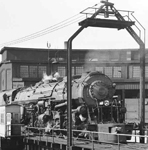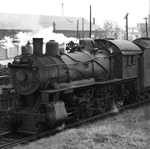Home ← Steam Railroads ← Norfolk & Western
Joyce Avenue Roundhouse

Click for Slide Show
N&W freight House

Click for Slide Show
Norfolk & Western Railroad
Scioto Valley Railroad (1876)
The Norfolk & Western Railway, in Columbus, was originally built as the Scioto Valley Railroad in 1876. It started as a Columbus, Circleville, Chillicothe short line that was extended to Portsmouth in 1878. At first it didn't have much on line business and no interchange business to speak of. That all changed when the little short line was purchased by the Norfolk & Western Railroad in July 1890. This gave the N&W, still building westward through West Virginia, an outlet to the west for its coal traffic. In the beginning it supplied coal to the Sandusky Short Line (later to become the PRR's Sandusky Branch). As time passed it also delivered coal to the PRR for the Logansport (Piqua) line, to the Chesapeake and Ohio for the Toledo docks and to the Toledo and Ohio Central (NYC) also for the Toledo docks.The line entered Columbus from the south passing through the city just west of Alum Creek to its yard in the northeastern section of Columbus north of Fifth Avenue. It terminated into the Joyce Avenue Yard, an "L" shaped yard that ended near Joyce Avenue where the roundhouse and locomotive servicing facilities were located. By the late 1920's the Joyce Avenue Yard had become too small and the many long freight trains were tying up traffic crossing E. Broad Street and many other Columbus east-west arteries. The Joyce Avenue yard and the PRR Grogan Receiving Yard (renamed Pennor Yard), located adjacent to the N&W yard, were greatly expanded and a high fill was built elevating the tracks through Columbus. This project eliminated 10 grade and two railroad crossings. It increase the capacity of the yard from 1,600 to 3,750 cars. The new PRR Pennor yard was expanded to 10 tracks.
Pennor yard was used for coal trains being transferred to the PRR Grogan Yard destined for the Lake Erie docks at Sandusky. The PRR also leased four tracks at the southwest corner of the Joyce Avenue Yard for staging coal trains destined for the PRR Piqua line to Logansport, IN. The interchange with the C&O and T&OC was just south of Columbus.
During the 1950's the N&W used the class A, 2-6-6-4 and, rarely, the class Y6, Y6a, or Y6b, 2-8-8-2 locomotives for road engines, the class S1a, 0-8-0 and usually one class M, 4-8-0 for switching service. K1, 4-8-2 and Y3, 2-8-8-2 locomotives were used on local freights between Columbus and Chillicothe. A class K2, 4-8-2 and occasionally a class J, 4-8-4 were used for the one passenger train, the "Pocahontas". The Columbus and Cincinnati sections of the Pocahontas were combined at Portsmouth for the trip to Norfolk, VA.
At the end of the steam era the N&W had the oldest active steam locomotive in Columbus, the class M build in 1906-07. They also had the newest locomotives the class S1a 0-8-0's a few built as late as 1953.
The N&W was characterized by its efficient well-maintained equipment as can be seen in photographs from the 1950s. Notice in the pictures how clean the locomotives are and how picked up the facilities are. This attention to a high level of maintenance lasted until the end of steam which was 1958 for Columbus and 1960 for the end of steam system wide.